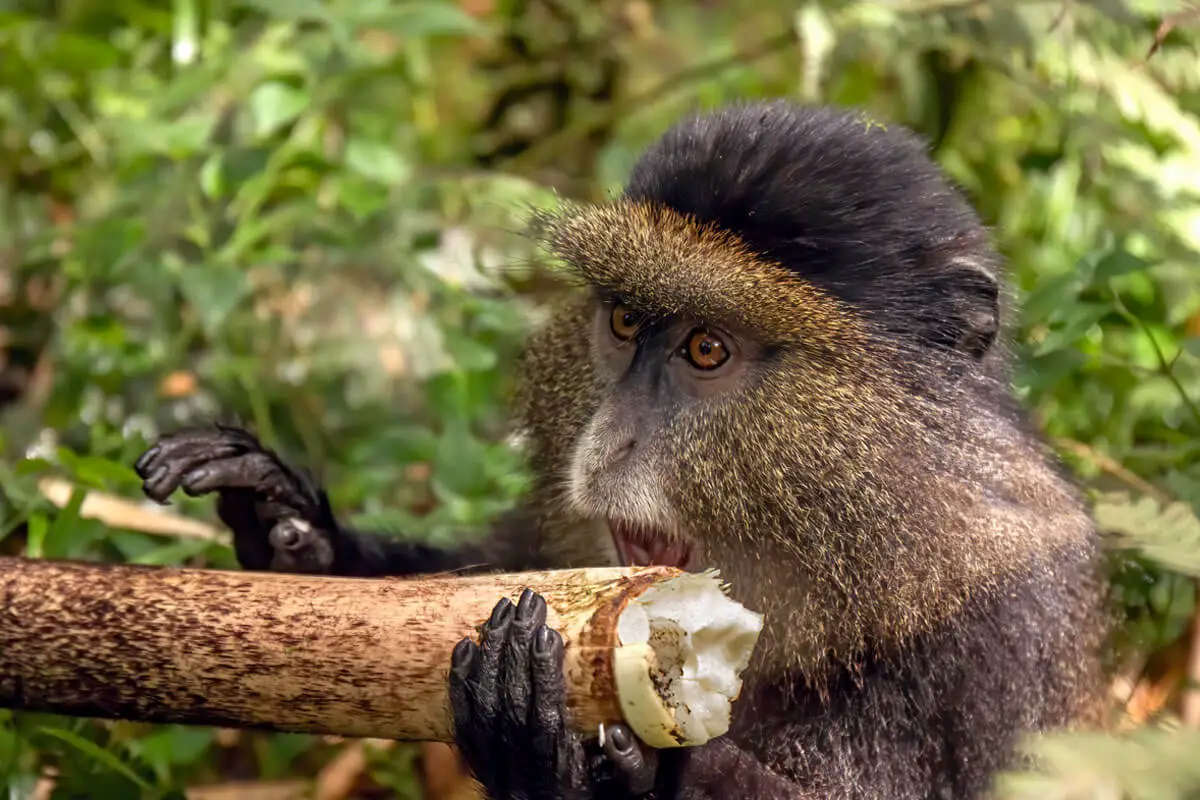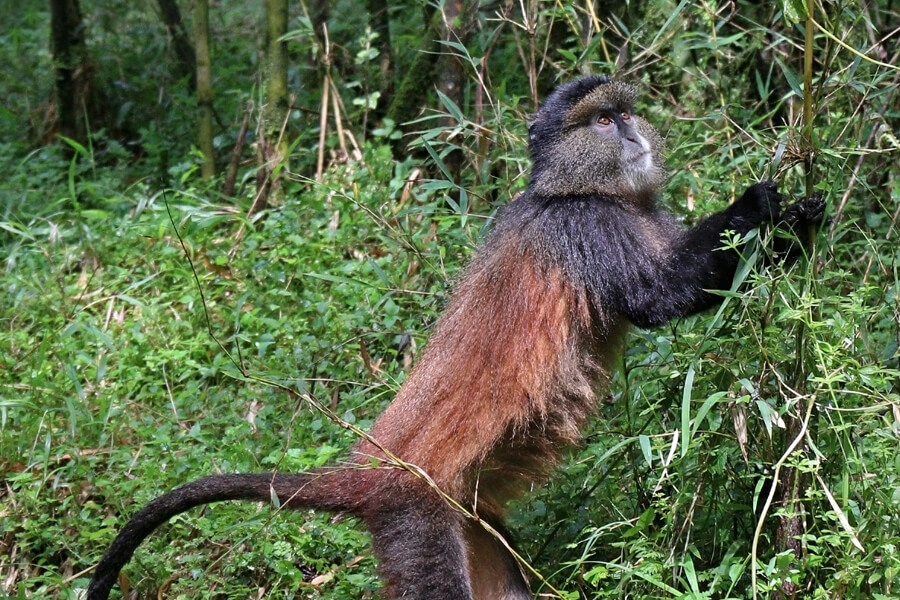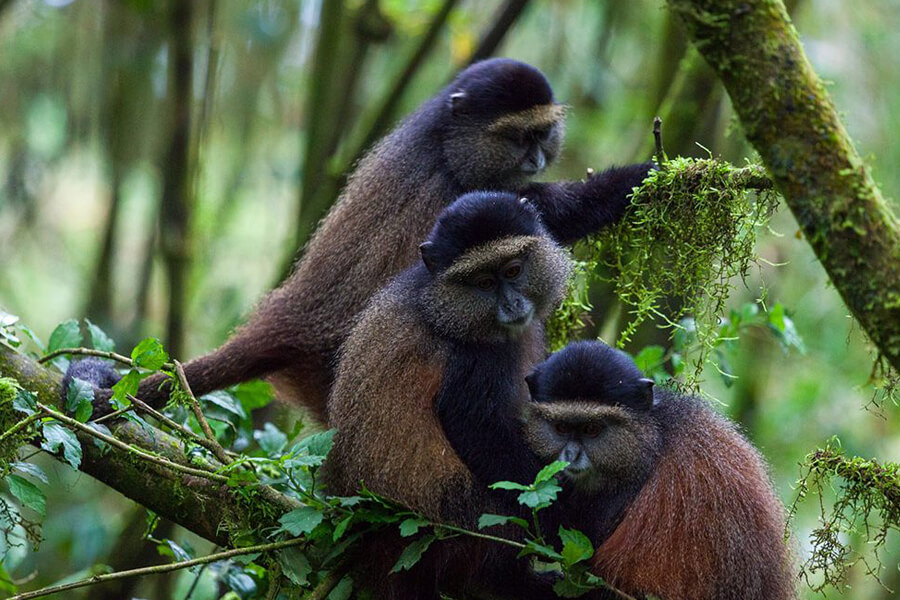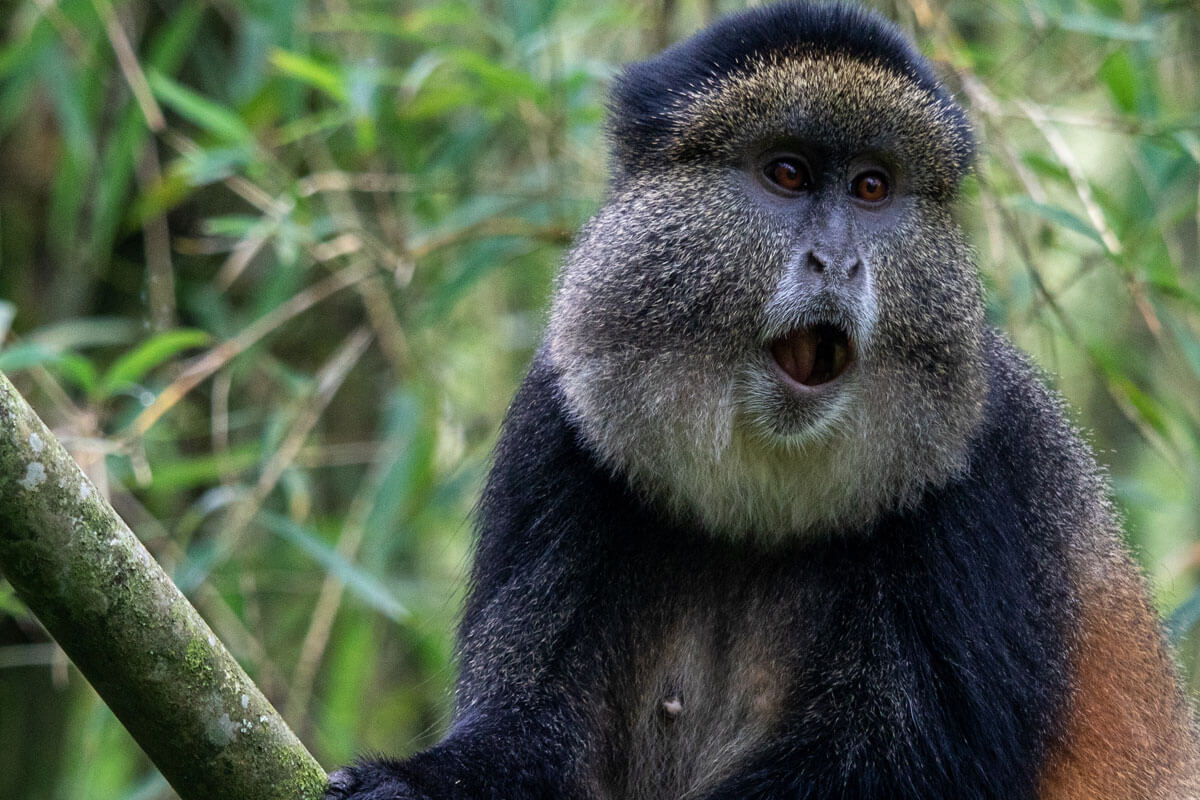Very Few animals are as fascinating as the golden monkeys, that live in the thick rainforests of Central Africa. Their Unique golden coats and interesting social behaviour are captivating to both casual and avid lovers of nature.
In this article, we will take a look at the intriguing world of the golden monkey and know more about their habitat, diet, social structures, conservations, and much more. In the end, you will know so much about the golden monkeys and where you can easily see them in the wild, as well as how that contributes positively to their survival.

So join us on this journey into the world of the golden monkey, and discover why they are such an important and cherished part of the natural world.
Facts About Golden Monkeys
1. Appearance
The golden monkey stands out from other monkeys thanks to its distinctive appearance. The thick coat of fur on these monkeys comes in a variety of colors, from orange to gold.
The fur of golden monkeys is longer and denser when compared with other monkeys. This is because golden monkeys live in high-altitude evergreen rainforests where it can get really cold. The longer and thicker fur is crucial for good insulation during bitterly cold nights.

2. Habitat
Golden monkeys like living in high-altitude forest areas in the heart of Africa. These thick rainforests are located at altitudes of more than 8000 feet (2440 meters) above sea level.
These forests are thick, cold, and often covered in fog and mist but are ideal for golden monkeys and contain a lot of their favorite food - bamboo.
3. Where To Golden Monkeys In The Wild
Golden monkeys can be found in the mountainous regions of central Africa, specifically in Rwanda, Uganda, and the Democratic Republic of the Congo. Golden monkeys live in a collection of mountains called the Virunga massif which is shared by the 3 countries of Uganda, Rwanda, and DR. Congo.
The best places to visit for golden monkey tracking in the wild are the Volcanoes and Mgahinga National Park of Rwanda and Uganda - respectively. With D.R. Congo, the tourism for golden monkeys, as well as gorillas, is still quite underdeveloped due to political instability in that part of the country.

4. Diet & Eating Habits
Golden monkeys are omnivores and therefore eat both plants and animals. Their diet consists of leaves, fruits, flowers as well as the occasional insects and small invertebrates found on the leaves.
The diet of a golden monkey changes heavily based on the availability of food in the areas as well as the change of seasons. During the dry season when most of the wild fruits are ripe, golden monkeys will feed on fruits for most of their daily food needs. In the wet season, the golden monkey will feed on many of the other plant parts like leaves and shoots, especially bamboo.
Related article: What do monkeys eat in the wild?
5. Size & Weight
The golden monkey is a medium-sized primate weighing up to 10 kilograms (20 pounds). In general, male golden monkeys are bigger than their female counterparts.
Male golden monkeys weigh 5 to 10 kilograms (10 - 20 lb) while females weigh between 3 and 7 kilograms (6-14 lb).
While Golden monkeys are not the smallest of primates, they are considerably small compared to the bigger primates like baboons, chimpanzees, and gorillas.
6. Social Structure
Golden monkeys are social and have been seen to move in groups that range from 3 individuals to troops of more than 50 individuals.

The groups vary in size depending on the altitude in which they live. Golden monkeys staying in higher altitudes tend to live in smaller groups than those living at slightly lower elevations.
The group/family is led by a dominant male golden monkey that is responsible for protecting the group from predators and invasions by other males. Females are in charge of looking after the young and foraging for food.
7. How Do Golden Monkeys Communicate
Golden monkeys communicate through a variety of vocalizations, body language, and facial expressions. They use different calls to signal various things such as alarm calls to warn others about predators, and soft grunts to indicate relaxation. They also use playful gestures like chasing and tickling to show their desire to play and bond with others.
Their body language also plays a significant role in communication. Facial expressions are also an important means of communication, conveying different emotions and intentions.
Aggression is indicated by threatening facial expressions like clenched jaws and intense gaze, whereas submission or a desire to play is shown by calm, wide-eyed facial expressions.
All these forms of communication help golden monkeys navigate their social world and interact with their troop.
8. How Golden Monkeys Sleep
Golden monkeys sleep in trees, often in groups. Sleeping in trees helps to protect them from predators and provides a safe place to rest during their inactive periods.
They use branches and leaves to build their nests, which they use for sleeping and resting. These nests are often located high in the canopy, providing the monkeys with protection from predators on the forest floor.
While Golden monkeys are diurnal - being active during the day and sleeping at night, they usually take short naps during the day to rest.
9. Reproduction
Golden monkeys mate and reproduce throughout the year and the female often gives birth to a single offspring after 5 months. The dominant golden monkey mates with all the females in the group.
The infant golden monkey is born with fur as well as being able to see and cling to the mother's fur. The young golden monkeys nurse for several months before slowly transitioning to solid food. The mother looks after her offspring for up to 2 years after which the young golden monkey is given full freedom to survive independently.
At around 3 to 4 years of age, the golden monkeys reach sexual maturity and are sent away from the group to go and form their groups. Males may form new families with other females or choose to take over the family of a dominant male they can beat. Females can join an existing family or start a new family together with another male.

10. Lifespan
Golden monkeys have a lifespan of around 20 years in the wild. However, their lifespan can vary depending on factors such as habitat quality, predation, and disease. In captivity, golden monkeys have been known to live up to 30 years.
While 20 years might seem short by human standards, this is almost twice as much as most well-known animals such as lions and leopards.
Related article: Lifespan Comparison. Which African animals live longest?
11. Close Animal Relatives
They are several species of monkeys that are classified under the genus cercopithesus and share a close relationship with the Golden monkey (cercopithesus kandti). They share some physical and behavioural characteristics and are known as Old World monkeys.
Here are some other monkey species that are closely related to golden monkeys.
| # | MONKEY SPECIES | SCIENTIFIC NAME |
|---|---|---|
| 1. | Blue monkey | Cercopithecus mitis |
| 2. | Diana monkey | Cercopithecus diana |
| 3. | Green monkey | Cercopithecus sabaeus |
| 4. | L'Hoest's monkey | Cercopithecus lhoesti |
| 5. | Mona monkey | Cercopithecus mona |
| 6. | Red-tailed monkey | Cercopithecus ascanius |
| 7. | Sykes' monkey | Cercopithecus albogularis |
| 8. | Vervet monkey | Cercopithecus aethiops |
12. Population In The Wild
The population of golden monkeys in the wild is estimated to be around 3,000 individuals. This number is declining due to habitat loss and hunting, which are the biggest threats to their survival.
Golden monkeys are found in a few protected areas in central Africa, including the Volcanoes National Park in Rwanda and Mgahinga Gorilla National Park in Uganda. Efforts are being made to protect their habitat and reduce hunting in order to ensure the survival of these endangered primates.
Despite these efforts, the population of golden monkeys remains vulnerable and in need of continued conservation efforts.
13. What Threatens Golden Monkeys
The biggest threat to golden monkeys is habitat loss due to deforestation, mining, and agriculture.
While golden monkeys are not hunted, they can sometimes get killed or seriously hurt by snares that are intended for poaching other animals.
14. Conservation Status
The golden monkey is listed as endangered by the International Union for Conservation of Nature (IUCN) with decreasing population trends. While research on golden monkeys is not as extensive as that on gorillas and chimpanzees, there are steps being taken to ensure a safe ecosystem for the golden monkeys.
Golden monkey tracking, as a tourism activity in Uganda and Rwanda, has increased awareness about these golden monkeys, and many visitors find it to be a gratifying experience.
Final Thoughts
Golden monkeys are fascinating primates with unique appearances and behaviour. Their striking golden fur and playful nature are not the full extent of their beauty. They live in beautiful, dreamy mountain forests, and seeing them with your own eyes is definitely a treat.
As an endangered species, any awareness and action towards protecting their natural ecosystem is a win for them and for us who will be able to pass on that gift to the coming generations. One of the ways for many people to contribute is through sustainable tourism which supports their conservation and protection.
A visit to Volcanoes National Park in Rwanda or Uganda's Mgahinga Gorilla National Park will give you a real-life experience with these beautiful golden monkeys in their dreamy natural habitat - and contribute toward preserving their natural home for future generations.
